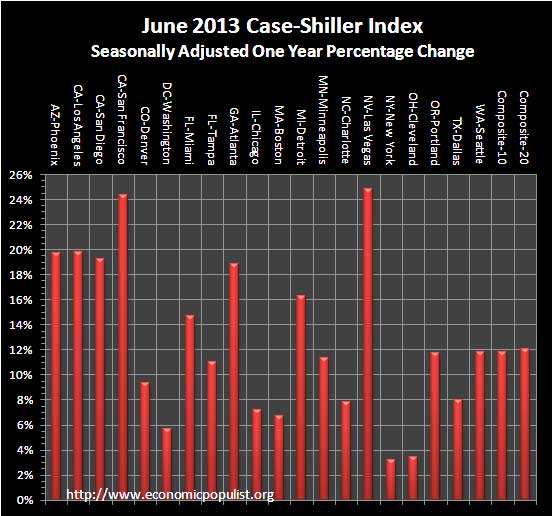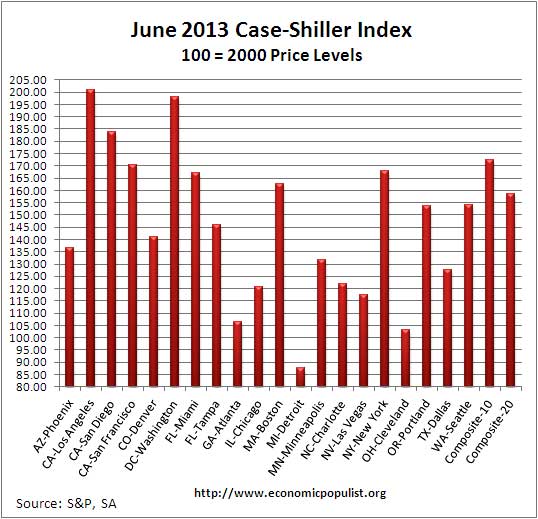The June 2013 S&P Case Shiller home price index shows a 12.1% price increase from a year ago for over 20 metropolitan housing markets and a 11.9% change for the top 10 housing markets from June 2012. This is a slightly lower annual increase than last month The national quarterly index increased 10.1% for the year. Not seasonally adjusted home prices are now comparable to April 2004 levels and the return to the housing bubble price levels is happening rapidly Graphed below is the yearly percent change in the composite-10 and composite-20 Case-Shiller Indices, not seasonally adjusted.

Below are all of the composite-20 index cities yearly price percentage change, using the seasonally adjusted data. San Francisco and Las Vegas are on fire as both have increased more than 24% in a year. San Francisco has jumped a whopping 47% from it's March 2009 low and the entire area has become absolutely insane. The average home price in Silicon valley is a cool million and rents are so exploitive, even six figure salaries cannot afford them. Overall the return to the the housing bubble has been clearly re-established as home prices are soaring out of reach again for most Americans.

S&P also produces a third national index. S&P is using the not seasonally adjusted national index when they report Q2 2013 home values are up 7.1% from Q1 2013, although the seasonally adjusted change is 2.3% between quarters. Below is the national index, not seasonally adjusted (blue), which are used as the headline numbers, against the seasonally adjusted one (maroon).

Below is the quarterly national index percent change from a year ago, now at 10.1%. The national index also shows soaring prices and a return to not affordable housing.

S&P reports the not seasonally adjusted data for their headlines. Housing is highly cyclical. Spring and early Summer are when most sales occur. See the bottom of this article for their reasoning. For the month, the not seasonally adjusted composite-20 percentage change was 2.2% whereas the seasonally adjusted change for the composite-20 was 0.9%. The monthly not seasonally adjusted composite-10 percentage change was 2.2%, whereas the seasonally adjusted composite-10 showed a 1.1% increase as well. This is summer, so the not seasonally adjusted increase should be significantly higher than the seasonally adjusted composite-20. The below graph shows the composite-10 and composite-20 city home prices indexes, seasonally adjusted. Prices are normalized to the year 2000. The index value of 150 means single family housing prices have appreciated, or increased 50% since 2000 in that particular region. Case-Shiller indices are not adjusted for inflation.

Some in the press use the seasonally adjusted data, and others do not. Some report the monthly change, others the annual change. S&P themselves use the not seasonally adjusted housing price data. To make matters worse, some in the press do not specify which statistic they are quoting from S&P. Below are the seasonally adjusted monthly home price percentage changes for each City reported by S&P. The thing to notice is the downturn in many markets. Since these are the seasonally adjusted indexes it shows the housing market might be cooling off from last month. To wit, S&P says the same thing using their not seasonally adjusted statistics:
Overall, the report shows that housing prices are rising but the pace may be slowing. Thirteen out of twenty cities saw their returns weaken from May to June. As we are in the middle of a seasonal buying period, we should expect to see the most gains. With interest rates rising to almost 4.6%, home buyers may be discouraged and sharp increases may be dampened.

Below are the seasonally adjusted indices for this month. The index itself tells you what has happened to home prices, per city, from the year 2000. Only Detroit is below their 2000 home price values with Cleveland just barely at 2000 price levels.

To Season or Not to Season, That is the Question:
The S&P/Case-Shiller Home Price Indices are calculated monthly using a three-month moving average and published with a two month lag. Their seasonal adjustment calculation is the standard used for all seasonal adjustments, the X-12 ARIMA, maintained by the Census.
So, why would S&P report the not seasonally adjusted data? According to their paper on seasonal adjustments, they claim the not seasonally adjusted indices are more accurate. It appears the housing bubble burst screwed up the cyclical seasonal pattern. What a surprise, although those steep cliff dives are now going back to 2009, one would think the seasonally adjusted data would now start to converge back to it's cyclical, seasonal pattern.
The turmoil in the housing market in the last few years has generated unusual movements that are easily mistaken for shifts in the normal seasonal patterns, resulting in larger seasonal adjustments and misleading results.
To see S&P's argument in action, look at the below graph. The maroon line is the seasonally adjusted national index, reported quarterly. The blue line is the not seasonally adjusted national index. As we can see before the housing bubble burst, we see a typical cyclical pattern difference between the seasonally adjusted and not seasonally adjusted data points. Yet after the bubble burst we see large swings, which would throw off a seasonal adjustment adaptive algorithm. This is going to become a major question among statisticians, how does one adjust for seasonality in the face of tsunami like economic events? Is it now long past the housing bubble collapse, yet we can see the seasonal adjustments still are not completely matching up from the year ago percent changes, which implies they are still off statistically.

Not seasonally adjusted data can create more headline buzz on a month by month basis due to the seasonality of the housing market. S&P does make it clear that data should be compared to a year ago, to remove seasonal patterns, yet claims monthly percentage changes should use not seasonally adjusted indices and data. This seems more invalid than dealing with the statistical anomalies the massive housing bubble burst caused. Below is the seasonally adjusted and not seasonally adjusted Composite-20 Case-Shiller monthly index, for comparison's sake.

For more Information:
S&P does a great job of making the Case-Shiller data and details available for further information and analysis on their website.
Here is our Case-Shiller past overviews as well as the overviews of residential real estate statistics.

Recent comments